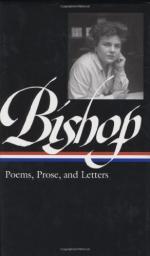|
This section contains 8,009 words (approx. 27 pages at 300 words per page) |

|
“Elizabeth Bishop: Perversity as Voice,” in American Poetry, Vol. 7, No. 2, Winter, 1990, pp. 31-49.
In the following essay, Brogan discusses Bishop's innovative use of poetic voice.
There may be no more traditional way of defining the “Poet”—and, by extension, the lyric itself—than that found in the “Preface to The Lyrical Ballads”: “What is a Poet? To whom does he address himself? And what language is expected from him?—He is a man speaking to men …” (italics mine). In recent years, the philosophical assumptions underlying these three questions (specifically the nature of author, audience, and the logos itself) have all been challenged by post-structuralist critics and theorists; certainly the sexual bias which informs the presumption of a masculine identity for author (and audience) throughout most of our canonized literature and criticism has been exposed by a number of recent feminist critiques.1 Nevertheless, our tendency to associate the lyric...
|
This section contains 8,009 words (approx. 27 pages at 300 words per page) |

|


